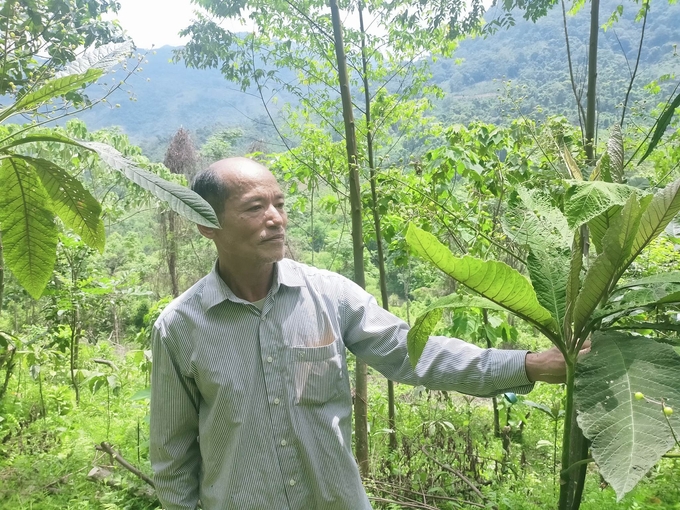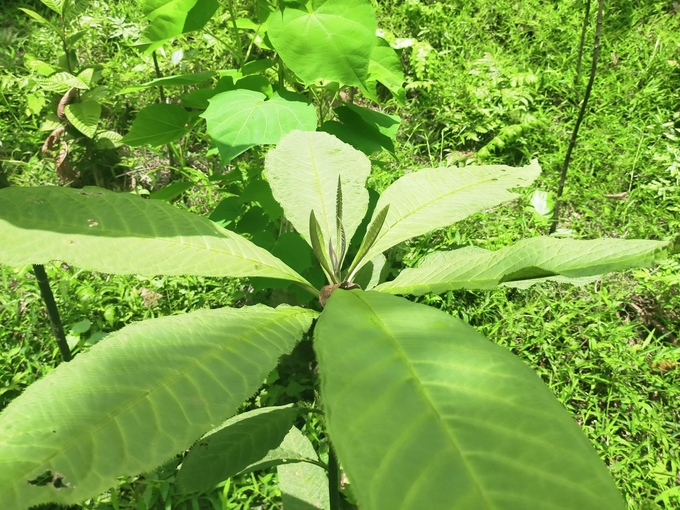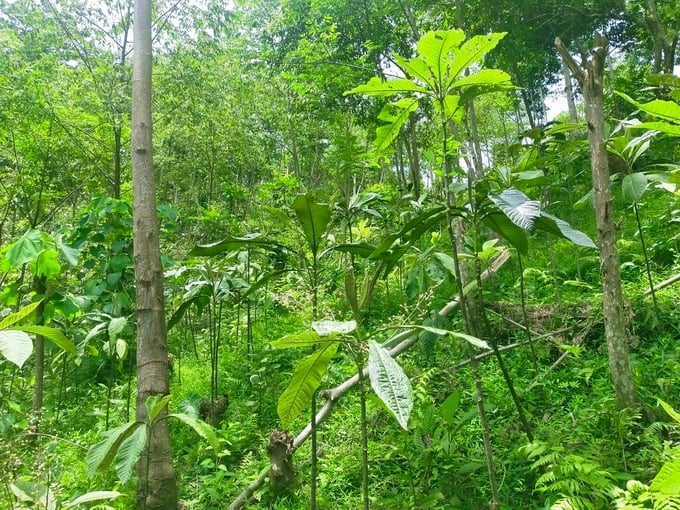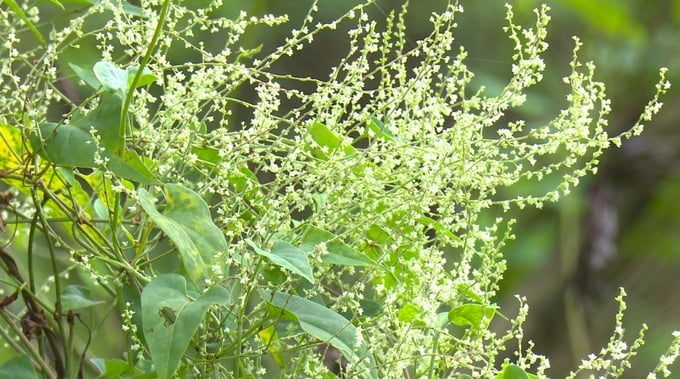June 17, 2025 | 00:19 GMT +7
June 17, 2025 | 00:19 GMT +7
Hotline: 0913.378.918
June 17, 2025 | 00:19 GMT +7
Hotline: 0913.378.918
Dong Phuc is a mountainous commune in the Ba Be district of Bac Kan province. Since there is less land suitable for paddy cultivation there, the residents depend primarily on forest planting. In lieu of planting acacia and manglietia conifera, which brought modest economic efficiency in the past, locals in Dong Phuc commune have adopted a new planting model of multi-storey, multi-canopy afforestation, combined with intercropping of medicinal plants beneath the forest canopy, thereby establishing a new development direction.

Mr. Duong Van Chan inspects the ardisia silvestris tree that has been planted for 2 years. Photo: Ngoc Tu.
The household of Duong Van Chan in Na Khau village (Dong Phuc commune) is the pioneer in developing the region's economy beneath the forest canopy. The 1.5 ha undulating areas have been planted with chestnut and black oak trees for many years, resulting in a large forested area with 5-meter-tall trees that cannot be harvested for 10 years. The family began growing golden camellia trees beneath the canopy of chestnut and canarium trees in 2019. This variety of trees prefers a cool climate, shade, and high-moisture soil, so it develops well when planted beneath the forest canopy. Currently, golden camellia has a very high value, with fresh flowers retailing for up to 500,000 VND per kilogram; therefore, it will provide a substantial source of income, as stated by Mr. Chan.
When the golden camellia tree began to form a canopy, Mr. Chan began to consider what types of trees to plant for a rapid harvest.
Chan's decision to join the commune coincided with the implementation of the model for sowing ardisia silvestris under the canopy. On his 1.5-hectare property, he planted 3,000 ardisia silvestris trees in 2021, which have flourished after two years. This species of tree prefers moist soil and mild air, and it can be planted beneath the forest canopy to create multiple strata.
"After one year, ardisia silvestris can be harvested four times per year. On an area of 1,000 square meters, 1 quintal of fresh leaves and nearly 30 kilograms of desiccated leaves can be harvested annually. Each hectare can generate approximately 60 million VND annually. Regarding the efficacy of ardisia silvestris, Mr. Chan remarked, "This is a significant source of income for mountain dwellers."

Ardisia silvestris planted under the forest canopy grows well. Photo: Ngoc Tu.
Dong Phuc commune is expanding the area of ardisia silvestris beneath the forest canopy as a result of the initial success of a few households in planting this plant.
Mr. Hoang Van Tue, chairman of the Dong Phuc Commune People's Committee, stated that the entire commune has planted and harvested more than 6 hectares. In reality, this tree has high economic efficiency, requires little maintenance, and is primarily planted beneath the canopy of a perennial forest. Businesses and merchants are entirely committed to this product.
With a province as mountainous as Bac Kan, the area of natural forest is expansive, but people are unable to plant new forests. As a result, the cultivation of ardisia silvestris is also highly advantageous, as it increases people's income and thus their motivation to protect the forest.
Mr. Hoang Van Hung, director of the Bac Kan Agricultural Extension Center, stated that the agricultural sector is expanding due to the initial success of the paradigm of planting ardisia silvestris beneath the forest canopy. Priority will be given to the buffer zones of special-use forests, where there is very little agricultural land. In 2021, the entire province will plant 60 hectares of ardisia silvestris; in 2022, another 60 hectares will be planted; and by 2024, an estimated 180 hectares will be planted.

Planting medicinal plants under the forest canopy helps to reduce soil erosion. Photo: Ngoc Tu.
"Ardisia silvestris is a medicinal plant that grows naturally in the area, but it has been depleted due to intensive harvesting. Mr. Hung stated that the revival of ardisia silvestris in the direction of commodity production not only makes economic sense, but also serves to enrich the flora and restore the native forest's ecological environment.
Planting medicinal plants beneath the forest canopy has been confirmed to be quite effective. Currently, dozens of cooperatives in Bac Kan province successfully cultivate medicinal plants.

Growing medicinal plants has been specially developed by Bac Kan province. Photo: Ngoc Tu.
In 2016, Bao Chau Medicinal Plantation and Production Cooperative, Van Lang Commune (Na Ri District) emphasized the cultivation of numerous medicinal plants, including ca gai leo or solanum procumbens, morinda root, and jiaogulan. These trees grow rapidly, produce a high yield, and are of high quality when planted beneath a canopy. After many years, a modest plantation has expanded to tens of hectares.
Bao Chau Pharmaceutical Cooperative has invested in processing machinery to create high-quality products with labels and origins, which are popular on the national market.
Currently, the cooperative continues to cultivate and propagate a variety of medicinal plants for regional residents to plant in order to create a sustainable raw material area. The cultivation and processing of medicinal products have provided many cooperative members with a stable income.
Resolution No. 10 dated April 22, 2021, of the Bac Kan Provincial Party Committee on the development of agriculture and forestry in the direction of concentrated commodity production, has established a target of planting 550 hectares of new medicinal plants connected to raw materials and preliminary processing and processing by 2025.

Bac Kan province has an abundant source of medicinal plants in nature. Photo: Ngoc Tu.
In 2022, 237ha of medicinal plants were planted in Bac Kan province, primarily fallopia multiflora, golden camellia, red pea eggplant, forest bitter gourd, jiaogulan, morinda root, berberidaceae, pink striped trumpet lily, and dandelion. The majority of these plants flourish beneath the forest canopy.
Plan No. 69/KH-UBND, dated February 8, 2023, was issued by the Bac Kan Provincial People's Committee in 2023 to support the development of medicinal herb cultivation areas.
Accordingly, the province of Bac Kan supports affiliated cooperatives in the production and utilization of medicinal products through consulting for link building, providing apparatus and equipment for project implementation, and constructing agricultural extension models, technical training, and seed support.
In Bac Kan, a number of projects on cultivating medicinal herbs under the forest canopy with high efficiencies, such as the "Research, evaluation, propagation, and techniques for growing Bac Kan rock ginger" project, have contributed to the successful preservation and propagation of ginger using the cell culture method.
In Liem Thuy commune, Na Ri district, the initiative has generated 22,000 tissue culture seedlings and constructed a 2-hectare ginger growing model. The results demonstrate that the model of cultivating tissue-cultured seedlings develops well, which is a significant basis for the province to consider and promote the expansion of the ginger growing area in the future years.
Translated by Linh Linh

(VAN) The working delegation from the Ministry of Agriculture and Environment conducted an important trip to the Netherlands to strengthen strategic partnerships and sustainable development in the agricultural sector.

(VAN) The letter ‘A Plea from the Ocean’ not only evokes emotion but also awakens the human conscience to the responsibility of protecting life on Earth.

(VAN) The Department of Agriculture in South Africa has announced the country’s first mass vaccination of poultry to prevent local birds from contracting avian influenza.

(VAN) Establishment of the Mekong Delta Regional Agricultural Linkage Center, aiming for a closed value chain, deep processing, trading platforms, and international market connectivity.

(VAN) Gia Lai province has recently recorded 460 rare species of animals and plants, contributing to forest conservation and biodiversity planning in the region.

(VAN) Ms. Caroline Beresford, New Zealand Ambassador to Vietnam, expressed confidence that agricultural cooperation between Vietnam and New Zealand will develop sustainably, be climate-resilient, and promote gender equality.

(VAN) Vietnam reaffirms its commitment to international cooperation in fostering sustainable and responsible fisheries while ensuring resilient livelihoods for small-scale fishing communities.